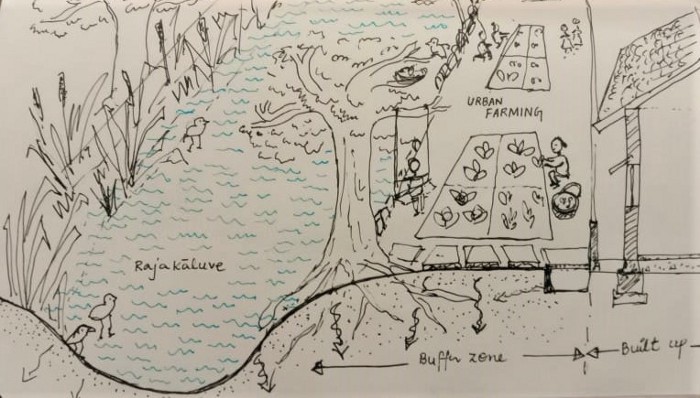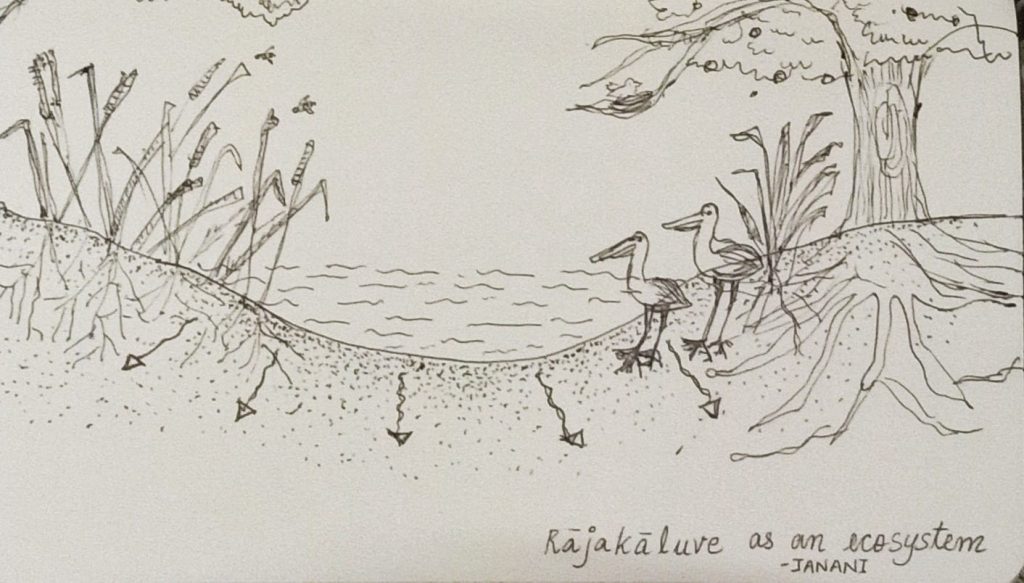LET US EMBRACE LIFE!
By Janani S, ESG
A REIMAGINATION OF STORM WATER STREAMS “RAJAKALUVES”
Cutting across the city, meanders the Rajakaluve stream travelling from lake to lake carrying the clean waters from the rain. The stream bed is lined with soil, large fruit trees adorn its entire side stretches. The Jamun fruits have been falling down. We pick them up and eat them, it makes our mouth so purple or ‘nerale’. Small wetland bushes have grown so thick on its slopes, they help in keeping the water and soil clean filtering the pollutants naturally. Birds are calling out, wading in the shallow waters. Me and my friends are sitting on a mango tree here. From here, we can get a birds eye view of the vegetable patch. We have have been watering these plants everyday. Now, the cabbages are almost ready to harvest. It goes into our midday meals — fresh and organic tomatoes, pumpkins, cabbages and palak. I’m very proud to tell you that this stretch of vegetable and green patch is maintained by my school. We even won the urban farming inter school competition, you know? Look at that fellow down there — “ Hey! Don’t you throw the plastic bottle into the stream! Don’t you know that this is the water we drink?”

The above paragraph paints a picture into the rich possibilities that can emerge as a result of community led ‘reclaiming of the commons’. In this case, the Rajakaluves and their mandated buffer zones are imagined to be a socio ecological system that benefits the community maintaining them. In a symbiotic relationship, community and ecology co-exist. The community meets its food and water needs through the arrangement and hence feels incentivized to take care of the ecology that supports it.
In Bengaluru, 800 km of Rajakaluve streams crisscross the city. The patches of urban farming and fruit trees that can be grown on its banks, in the no development zone, is a humongous opportunity for the wide public. School children, who currently have very minimal ground connect, would be exposed to touch, feel and stay connected to the earth and water, birds and seasons.
Back to history: What happened to the beautiful lakes of yester years?
Bengaluru was once known as the city of lakes, with over a 1000 of them dotting its landscapes. Due to its geographical location away from any major river, a socio ecological system of building and managing tanks was devised and perfected as the means to supply water for domestic and irrigation needs for centuries. Up until recent 1970s, when the Cauvery river water, 90km away from Bengaluru was piped, pumped and made available at residences across the city, the decentralized system of tanks was an essential component in the urban plan, its maintenance and water quality a matter of concern to all the residents.
Current situation: Where are we today?
Fast forward to present day, one finds polluted, encroached and degrading lake systems across the city. Lakes are interconnected by a series of streams, termed as rajakaluves, which are the lifelines bringing in rainwater from the the upstream lakes. The fundamental reason behind the slow death of the water systems can be attributed to the complete disconnect of communities and water supply systems.
Civil society and public efforts drew attention to the need to protect lakes with the existing provisions of PILs in the judicial system. Through ESG Environment Support Group and other organisations’ efforts, the need to protect lakes and their feeder Rajakaluves was recognised in the law. A buffer zone where no-development is allowed has been earmarked around both the lakes and Rajakaluves. Yet, this is only the beginning of the conservation story.
Current efforts to evacuate encroachments and concretize the Rajakaluves are still in stark contrast to lively and vibrant social cultures imagined in this essay. Concretization of Rajakaluves, apart from being an extremely expensive and highly resource intensive exercise, destroys any hope for community connect with the water systems. The question of whether Akrama Sakrama will be used to regularize the properties aldready developed in the buffer zones also remains unanswered. The onus lies on the public to prioritize water and food security. Mandating buffer zones and evicting encroachments are a great first step, but public imagination and re connect with the ecological system is the most sustainable way forward.


Ecologically sensitive design of Rajakaluve makes way for an ecosystem; Concretization of Rajakaluve in Subramaniapura, Bangalore- July 2021
First Published on: Medium.com


Hi I want to get involved in all environmental activities from your organization for betterment of namma bengaluru hence please inform me about all future events conducted by your organization thanks in advance.